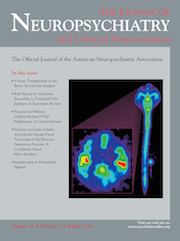To the Editor: Sick sinus syndrome (SSS) is characterized by dysfunction of the sinoatrial (SA) node that is often secondary to degeneration of the SA node and surrounding atrial myocardium. This could result in profound sinus bradycardia, sinus pauses, sinus arrest, SA nodal exit block, and inappropriate responses to physiological demands during exercise or stress. SSS can also be accompanied by AV nodal conduction disturbances and by paroxysmal supraventricular tachycardia as part of the tachycardia–bradycardia syndrome. Patients may present with symptoms of fatigue, lightheadedness, presyncope, syncope, dyspnea on exertion, angina, and/or palpitations. Drugs that depress sinus node function, including drugs that increase cholinergic tone, have been associated with SSS.
We report on a 72-year-old man who presented to the emergency department (ED) with two episodes of syncope in the week before his presentation. He described his episodes as having symptoms of lightheadedness and then passing out in a short duration. On presentation to the ED, his symptoms had resolved, and he was completely asymptomatic. The patient had a past medical history of hypertension, diabetes mellitus, and recently-diagnosed Alzheimer’s dementia. He was on lisinopril and metformin and was on donepezil 5 mg, which had been increased to 10 mg 2 weeks earlier. He reported not having such symptoms in the past, and there was no family history of any cardiac disease. On examination, the patient was hemodynamically stable, with his physical examination within normal limits. His electrocardiogram showed normal sinus rhythm, and his laboratory findings were benign. The patient was admitted to the hospital with continuous cardiac monitoring for observation and work-up of his symptoms. The patient started complaining of some lightheadedness the next morning, and his cardiac recording demonstrated prolonged bradycardia, with a pulse of around 30 beats per minute, followed by a 10-second sinus pause, and then resolving, with atrial fibrillation that lasted a day before converting to normal sinus rhythm. The patient’s symptoms were explained with his recorded arrhythmia; however, the cause was not known. Investigating for reversible causes, a possible adverse effect of donepezil, using the Naranjo algorithim,
1 was determined. The patient was educated about the same, and donepezil was discontinued. The patient has been followed up and has not had any more symptoms or reported problem with his arrhythmia.
Donepezil is reversible acetylcholinesterase inhibitor that has been approved by the Food and Drug Administration for the treatment of Alzheimer’s disease. Although rarely reported, acetylcholinesterase inhibitors have the potential to exert vagotonic effects on the SA, resulting in symptomatic bradyarrhythmias. In a case series among patients on donepezil experiencing syncope, 69% of patients had an identifiable etiology, with sinus node dysfunction being the most common cause.
2 Our case describes a patient with symptomatic bradyarrhythmia most likely due to donepezil, who improved after discontinuation of the drug. With a growing geriatric population, physicians will be seeing more patients on acetylcholinesterase inhibitors, and identifying this as a reversible cause of bradyarrhythmia associated syncope would be essential.

